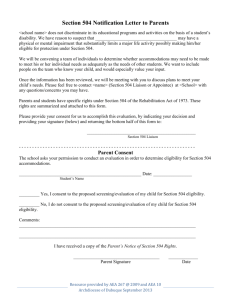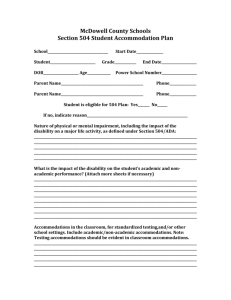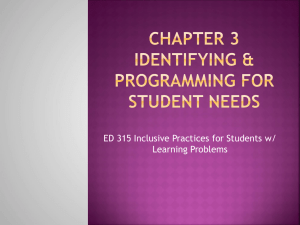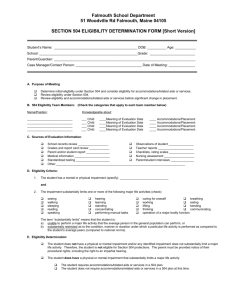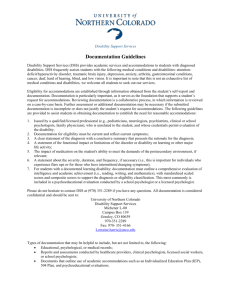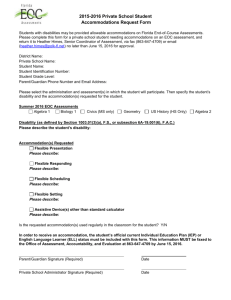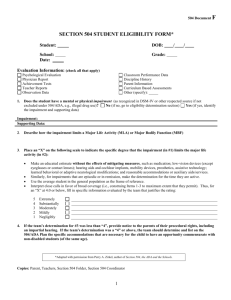A Parent Guide to 504
advertisement
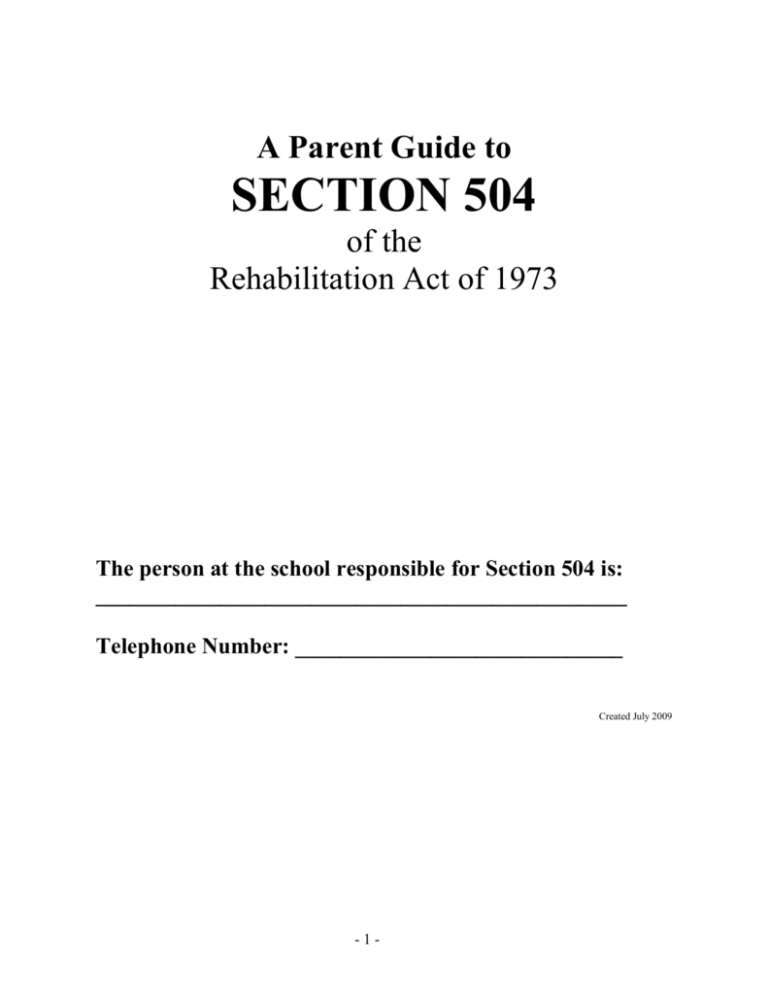
A Parent Guide to SECTION 504 of the Rehabilitation Act of 1973 The person at the school responsible for Section 504 is: _______________________________________________ Telephone Number: _____________________________ Created July 2009 -1- A Parent Guide to Section 504 is designed to give parents a short overview of Section 504 of the Rehabilitation Act of 1973 as it pertains to Cedar Rapids Community Schools. While Section 504 defines the equal access requirements for both students and employees, this publication will focus on students. This information has been organized around questions parents frequently ask when trying to understand this civil rights statute. Please note that when working with disabled students, Section 504 serves the same purpose as the ADA (Americans with Disabilities Act). Consequently, this publication focuses solely on Section 504. What is Section 504? Section 504 of the Rehabilitation Act of 1973 is Congress’s directive to schools receiving any federal funding to eliminate discrimination based on disability from all aspects of school operation. Since the Cedar Rapids Community School district receives federal dollars, it is required to provide eligible disabled students with equal access to services, programs, and activities offered by the District. Section 504 is a civil rights statute and not a special education statute. Therefore, it is the responsibility of regular education staff and building administration to implement those practices and procedures necessary for a school to fulfill the requirements of this law. It is also important to understand that schools receive no additional funding to implement Section 504 accommodations. At each school, the responsibility for ensuring Section 504 compliance rests with the building principal or principal’s designee. What criteria are used to determine if a student is eligible for a Section 504 plan? Like other students, those students with a disability, as defined by Section 504, are entitled to a free appropriate public education. An appropriate education for a Section 504 disabled student may require the provision of specific accommodations and related services in order to meet the needs of the student. Section 504 focuses on ensuring a level of access to educational services and the learning process for qualified disabled students that is equal to that given non-disabled students. Students eligible for Section 504 accommodation plans must meet three criteria. The three criteria are (1) A mental or physical impairment, (2) which substantially limits, (3) one or more major life activities. It is important to understand that all three criteria must be present for a student to be eligible for a Section 504 accommodation plan. Equally important, this disability must be why the student cannot equally access or receive benefit from the school’s programs and services. Here is additional information on each of the three criteria. Mental or physical impairment: This includes any physiological disorder or condition, cosmetic disfigurement, or anatomical loss affecting one or more body systems. Additionally, this can include any mental or psychological disorder. This criterion does not limit eligibility to specific diseases or categories of medical conditions. The law was intentionally written this way to avoid limiting the range of diseases or medical conditions that might be considered for Section 504 eligibility. -2- Substantially limits: Section 504 does not specifically define the term “substantially limits.” The basis for evaluating this criterion is the impact a disability has on one or more of a student’s major life activities. It is vital to understand that for a student to qualify for Section 504, the impairment must impose a considerable limitation on one or more major life activities. The eligibility team will consider the nature and severity of the disability as well as how long the disability is expected to last. Simply having a condition or disability does not automatically qualify a student for Section 504 protection. The condition must present a barrier to the student’s ability to access the same educational opportunities as a non-disabled student. Major life activities: Major life activities include such things as: seeing, hearing, eating, sleeping, walking, standing, lifting, bending, speaking, working, breathing, learning, reading, communicating, thinking, concentrating, caring for oneself, and performing manual tasks. The operation of major bodily functions (e.g., the functions of the immune system, normal cell growth, and digestive, bowel, bladder, respiratory, circulatory, endocrine, neurological, brain, and reproductive functioning) count as major life activities. Please note that this list of major life activities is not exhaustive. How is a Section 504 review request made? A parent, guardian, teacher, building team, counselor, related service provider, other school staff, administrator, or community agency can initiate a referral for Section 504 eligibility to the building intervention team. This team looks different in each building, but usually involves administrators, counselors, and GWAEA staff. It is a good idea to discuss the appropriateness of a 504 Plan with your child’s teacher, counselor, building 504 coordinator or principal before making the referral, as there are numerous intervention strategies used with students. By discussing your concerns with one of these people, it can be determined if a pursuing a 504 Plan will best support the student’s needs. What process is used in determining if a student is eligible for a Section 504 plan? Upon receipt of a 504 referral, the school-level building intervention team will determine whether or not an evaluation will occur. If an evaluation will occur, the Coordinator will arrange a meeting (or have a phone call) with parents to review the referral and discuss the evaluation process. The Coordinator will also make arrangements for a 504 team meeting to review the referral and determine the evaluation data that should be collected, as well as set a date for an eligibility determination meeting. As mentioned above, a student is eligible for Section 504 protection when it is determined by the 504 team that he/she has a physical or mental impairment that substantially limits one or more of the major life activities, and the impairment is impacting access and student benefit from school programs and services. A properly convened eligibility team needs to include individuals who are knowledgeable about the needs of the student, the interpretation of the data being reviewed, and the accommodation/service options available. This team can include (but -3- is not limited to) parents/guardians, teachers, counselors, related service providers, other school staff and administrators, and staff from community agencies. Parents/guardians should be included in this process whenever possible. The team’s first responsibility is to review the nature of the impairment and determine how it affects the student’s access to educational programs and activities. Section 504 eligibility meetings are not intended to be as comprehensive as a special education evaluation. However, in every case, the eligibility team needs to investigate the specific concern that triggered the request. Information that might be considered includes (but is not limited to): grades, attendance reports, behavior plans, cumulative file information, psychological evaluations, medical information, observations, and standardized testing information. As needed, the eligibility team may administer and use other formal and informal measures that help them determine 504 eligibility. Parents will be asked to consent to obtain these measures. How are 504 accommodations and related services documented and reviewed? If the eligibility team determines that a student has a Section 504 disability, the team’s second responsibility is to identify the specific accommodations or services that will support equal access. Documentation of these accommodations is done in a Section 504 Accommodation Plan. This plan provides a summary of the accommodations that a student requires to ensure equal access to the learning process and/or district programs, activities, and services. This document becomes part of the student’s cumulative file. 504 eligibility teams review active Section 504 Accommodation Plans yearly with more frequent meetings occurring if needed. The purpose of a yearly review is to add, subtract and/or modify student accommodations as needed. If a student no longer needs a 504 Plan, the eligibility team terminates it at a review session. What is meant by the word “accommodation”? Where will the accommodations occur? Section 504 requires that a student with an eligible disability be educated with students who do not have disabilities to the maximum extent appropriate. This is referred to as educating the student in the least restrictive environment. Implementation of most Section 504 Plans occurs in the regular classroom. Accommodations generally are those minor adjustments to things like seating arrangements, lesson presentation, assignments, and other facets of the learning environment that provide the student with equal access to learning opportunities. An example might be moving the student to a position in the room that best supports his/her ability to focus on schoolwork. Accommodations might involve the use of such things as special visual aids, large print, or using video recordings. Allowing a student additional time to complete a specific kind of task is also an accommodation. There are countless accommodations that can support a student’s equal access to educational opportunities. It is the job of the eligibility team to identify those accommodations that will support the needs of a given student resulting from the identified impairment. Please keep in mind that each school will include accommodations that it has the ability to accomplish based on what the school offers to all students and resources available to implement its programs and -4- services. This means that accommodations will be designed differently at different schools and at different levels (elementary, middle, high school). What rights do parents (and students) have under Section 504? The following is a list of parent rights granted by federal law. The intent of the law is to keep parents fully informed concerning decisions made about their children and to inform them of their rights should disagreement occur over a 504 decision. As a parent, you have the right to: Have your child take part in, and receive benefit from, public education programs without discrimination based on a disability. Have the district advise you as to your rights under the law. Receive notice with respect to the identification, evaluation, or placement of your child. Have your child receive a free appropriate public education. This includes the right to be educated with non-disabled students to the maximum extent appropriate. It also includes the right to have the district make reasonable accommodations to allow your child an equal opportunity to participate in school and school-related activities. Have your child educated in facilities and receive services comparable to those provided students without disabilities. Have your child receive special education and related services if she/he is found to be eligible under the Individuals with Disabilities Education Act (IDEA), or to receive reasonable accommodations under Section 504 of the Rehabilitation Act. Have eligibility and educational placement decisions made based upon a variety of information sources, and by individuals who know the student, the eligibility data, and placement options. Give your child an equal opportunity to participate in non-academic and extracurricular activities offered by the district through the provision of reasonable accommodations. Examine all relevant records relating to decisions regarding your child’s identification, eligibility, educational program, and placement. Obtain copies of educational records at a reasonable cost unless the fee would effectively deny you access to the records. Receive a response from the district to reasonable requests for explanations and interpretations of your child’s records. Request amendment of your child’s educational records if there is a reasonable cause to believe that they are inaccurate, misleading or otherwise in violation of the privacy rights of your child. File a complaint with the district when you believe your child’s rights have been violated. -5- Request an impartial hearing related to decisions regarding your child’s identification, eligibility, and educational placement. You and your child may take part in the hearing and have an attorney present at your own cost. File a formal complaint with the Iowa Department of Education or the U.S. Department of Education Office for Civil Rights (Region VII): Whom should parents contact when they have a Section 504 complaint? The best solutions to parent and student concerns occur at the school level. Therefore, the first step in resolving a complaint involves the parent or guardian contacting the building principal and discussing the issue with the principal and other appropriate building staff. If the issue is not resolved through these discussions, the parent or guardian can file a Section 504 Complaint Form with the school principal. A sample Complaint form is included in this handout. The form is also available at your local school. If the issue is not resolved at the building level, the parent or guardian can continue the complaint process by forwarding a copy of the complaint to the district’s Section 504 Coordinator. The Section 504 Coordinator will work with the Section 504 Compliance Officer in reviewing and responding to the parent concern. If the concern is still not resolved, the Superintendent or designee will review the decision to determine if all district and 504 policies have been followed. Information on how to contact Section 504 Coordinators and the Section 504 Compliance Officer is provided on the last page of this document. As noted above, you also have the right to request an impartial hearing related to any decisions regarding your child’s identification, eligibility, and educational placement. Request for hearings shall be submitted to the District 504 Compliance Officer. Upon receiving a written request for a hearing, the District 504 Compliance Officer will contact a Resolution Facilitator from Grant Wood Area Education Agency who hears cases pursuant to the Individuals with Disabilities Education Act and who has been trained regarding Section 504. The hearing officer will schedule a due process hearing to occur as soon as reasonably possible for the parent/legal guardian and district. The parent/legal guardian and district may be represented by legal counsel at the hearing, may examine relevant records, and participate in the hearing. Within ten (10) school days after the conclusion of the hearing, the hearing officer will render a written decision. The written decision shall include applicable findings of fact and conclusions of law. The hearing officer shall submit the written decision to the parent/legal guardian and to the Board of Education. The decision of the hearing officer shall constitute the final administrative decision on the Section 504 matter. Finally, note that the Office for Civil Rights (OCR) is the federal agency responsible for enforcing Section 504 compliance. While we believe that the best resolutions occur at the school level, parents/guardians always have the right to initiate a complaint with the OCR. -6-

